Keywords
|
| Power factor correction (PFC); PMBLDC motor; Hall sensors;bridgeless PFC Converter. |
INTRODUCTION
|
| Permanent magnet brushless DC (PMBLDC) motors are the latest choice of drives due to their high efficiency, silent operation, compact size, high reliability and low maintenance requirements. The Brushless DC Motor is a rotating electric motor consisting of stator armature windings and rotor permanent magnets. Brushless DC motors is a kind of permanent magnet synchronous motor. Permanent magnet synchronous motors are classified on the basis of the wave shape of their induce emf, i.e., sinusoidal and trapezoidal. The sinusoidal type is known as permanent magnet synchronous motor; the trapezoidal type goes under the name of PM Brushless dc (BLDC) machine. As the name suggests brushes are absent in PMBLDC motor and hence in this case, commutation is implemented electronically by using semiconductor switches to change current in the windings based on rotor position feedback. The rotor position can be sensed using Hall sensors, resolvers, or optical encoders. PMBLDC motor is suitable for high speed and low power applications due to high efficiency and wide speed control. They are used in industries such as Automotive, Aerospace, Consumer, Medical, Industrial Automation Equipment and Instrumentation [3], [4], [5]. Brushless dc motors are now being used in refrigeration compressors, washing machines, fans, food processing equipment and vacuum cleaners in the household appliances. The VSI fed PMBLDC motoris powered through a three-phase voltage source inverter (VSI) which is fed from single-phase AC supply using a diode bridge rectifier followed by a smoothening DC link capacitor. This arrangement suffers from power quality (PQ) disturbances such as poor power factor (PF), increased total harmonic distortion (THD) of current at input AC mains. It is mainly due to uncontrolled charging of the DC link capacitor [1], [2]. In order to reduce the harmonic current pollution, most inverters are equipped with power factor correction converter as front AC/DC converter. But the conventional PFC converters are composed of a full bridge diode rectifier followed by a boost converter, and these power components result in power loss, low efficiency and high cost [6]. Research on PFC circuits for high power applications has increased. PFC using bridgeless boost converters is the recent trend. In these rectifiersthe two diodes of conventional topology replaced by using one MOSFET body diode, thus reducing the conduction losses. The back-emf of the PMBLDCM is proportional to the motor speed and the developed torque is proportional to its phase current, a constant torque is maintained by a constant current in the stator winding of the PMBLDCM whereas the speed can be controlled by varying the terminal voltage of the motor. Based on this logic, a speed control scheme is proposed in this paper which uses a reference voltage at DC link proportional to the desired speed of the PMBLDC motor. The control of VSI is only for electronic commutation which is based on the rotor position signals of the PMBLDC motor. The classical PI controller is a wide used controller [1]. |
PMBLDC DRIVE SYSTEM
|
| The main problems faced by the conventional inverter fed BLDC motor is poor quality of voltage and current, due to the presence of harmonics and hence there is significant level of energy losses. In this paper an improved bridgeless PFC boost rectifier is proposed to improve power factor, to save energy, to suppress harmonic current and to improve drive performance of a BLDC motor. The simulation study reveals that the input power factor in bridgeless boost rectifier fed PMBLDC motor is improved and generate less THD. |
| Fig.1. shows simplified block diagram of VSI fed PMBLDC drive system [1]. In this scheme the ac supply is given to the PFC converter and its output is fed to dc link capacitor. The DC link is connected to input of inverter and its output is fed to PMBLDC motor. In this system the rotor position is measured using Hall sensors. By varying the voltage across the motor, we can control the speed of the motor. Two control loops are used in this system. The inner loop synchronizes the inverter gates signals with the electromotive forces. The outer loop controls the motor's speed by varying the DC bus voltage. Commutation ensures proper rotor rotation of the BLDC motor, while the motor speed depends only on the amplitude of the applied voltage. The required speed is controlled by a speed controller, which is implemented as a conventional proportional-integral (PI) controller. The difference between the actual and required speeds is input to the PI controller which then, based on this difference, varying the DC bus voltage. |
POWER FACTOR CORRECTION CONVERTERS
|
| In recent years, there have been increasing demands for high power factor and low total harmonic distortion (THD) in the current drawn from the utility. With the requirements of power quality power-factor correction (PFC) has been an active research topic in power electronics, and significant efforts have been made on the developments of the PFC converters. The boost topology has been widely used as a PFC converter because of its simplicity and high power capability [7], [8]. It can be used with the universal input voltage range. Conventional PFC converter improves the PF by using preregulator circuit (boost converter) at the output side of bridge rectifier, but not approaches to unity power factor and also decreases the converter efficiency because of high conduction losses. The conventional PFC converter always includes 3 semiconductor voltage drops in the current flow path. In this paper an improved bridgeless PFC boost rectifier is proposed to save energy, to suppress harmonic current and to improve drive performance of a BLDC motor. Conventional bridged PFC topology is replaced by bridgeless PFC topology, there are only two semiconductors in any given conduction path. |
| Fig. 2 shows the Conventional boost PFC converter. Conventional boost PFC converters are composed of a full bridge AC to DC diode rectifier followed by a pre regulator circuit. The bridge-rectifieroffers high conduction losses which lowers the system efficiency. The basic topology of the bridgeless PFC boost rectifier [8] is shown in Fig. 3. Compared to the conventional PFC boost rectifier, which omits rectifier-bridge, one diode is eliminated from the line-current path, so that the line current simultaneously flows through only two semiconductors resulting in reduced conduction losses and is able to achieve higher efficiency and it also reduces THD, improves the power factor to unity. Bridgeless boost PFC omits rectifier-bridge and also maintains the classic boost topology. This topology replaces the two diodes of the conventional topology by using one MOSFET body diode; the inductor is split and placed at the AC side to perform the boost structure. |
| During positive cycle, When MOSFET M1 turns on, the inductor L1 stores energy and current flows through the path inductor L1, MOSFET M1, internal diode D4 of MOSFET M2, inductor L2.As M1 turns off, L1 discharges stored energy by D1 to load and current flows through the path- diode D1, load RL, internal diode D4 of MOSFET M2, inductor L2, input line. .During negative half cycle When MOSFET M2 turns on, the inductor L2 stores energy and current flows through the path- inductor L2, MOSFET M2, internal diode D3 of MOSFET M1, inductor L1. As M2 turns off, L2 discharges stored energy by D2 to load and current flows through the path- diode D2, load RL, internal diode D3 of MOSFET M1, inductor L1, input line. The MOSFET M1 can be driven on/off only in positive half cycle and the MOSFET M2 only in the negative half cycle. Both MOSFETs can be driven on and off simultaneously because of the freewheeling diodes D3 and D4, providing the right flow of the current in each alteration of the input line. However, the bridgeless PFC converter has significantly larger common-mode noise than the conventional PFC converter. The common-mode noise reduced by modifying the basic bridgeless PFC converter. The bridgeless PFC converter is modified by adding two diodes [8]. |
SIMULATION RESULTS OF VSI FED PMBLDC MOTOR (WITH AND WITHOUT PRE REGULATOR).
|
| Simulation results of VSI fed PMBLDC Motor (with and without preregulator) are compared with Bridgeless PFC converter fed PMBLDC Motor. Conventional VSI fed PMBLDC Motor without pre regulator is shown in fig. 4(a). Input voltage and current waveforms are shown in fig. 4(b). It can be seen that the current is not in phase with voltage. By measuring the reactive power and active (i.e. 168VAR and 365W) the power factor is calculated. Power factor is very less i.e. 0.90. The variation of speed is shown in fig. 4(c). FFT analysis done for the input current and the THD is found to be 79.29% as shown in fig. 4(d). |
| The power factor can be further increased by using pre regulator circuit. Conventional VSI fed PMBLDC Motor with pre regulator circuit is shown in fig. 5(a). Input voltage and current waveforms are shown in fig. 5(b). The reactive power is 167VAR and active power is577W, hence the power factor is improvedi.e. 0.96, but not approaches to unity. The variation of speed is shown in fig. 5(c). FFT analysis done for the input current and the THD is found to be 68.88% as shown in fig. 5(d). |
SIMULATION RESULTS OF BRIDGELESS PFC CONVERTER FED PMBLDC MOTOR
|
| Bridgeless PFC converter fed PMBLDC Motor system is shown in fig. 6(a). Input voltage and current waveforms are shown in fig. 6(b). It can be seen that the current is almost in phase with voltage. Hence it shows that the power factor is nearly unity.The reactive power is 25VAR and active power is655W, hence the power factor is nearly unity,i.e. 0.999. The variation of speed is shown in fig. 6(c). FFT analysis done for the input current and the THD is found to be 34.29% as shown in fig. 6(d). |
CONCLUSION
|
| This paper presents simulation results of a Conventional VSI fed PMBLDC motor (with and without pre regulator) and bridgeless PFC converter fed PMBLDC motor. The power factor is corrected by using PFC converter. With bridgeless PFC converter it is possible to improve the power factor, suppress harmonic current and improve drive performance. In bridgeless PFC converter fed BLDC drive system power factor is improved to nearly unity. It is found that THD can be reduced to 34.29% by using bridgeless PFC converter. |
Figures at a glance
|
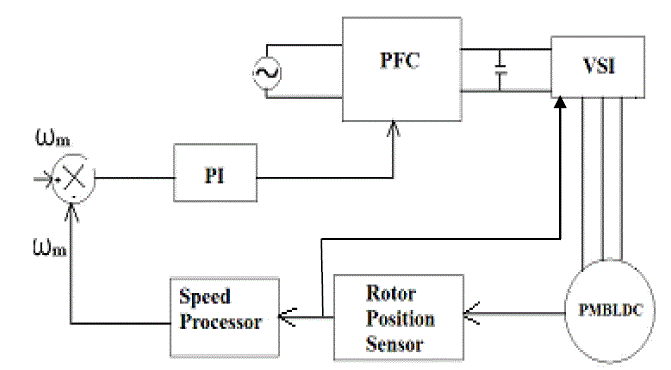 |
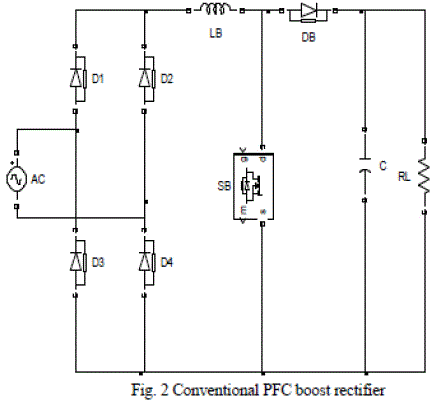 |
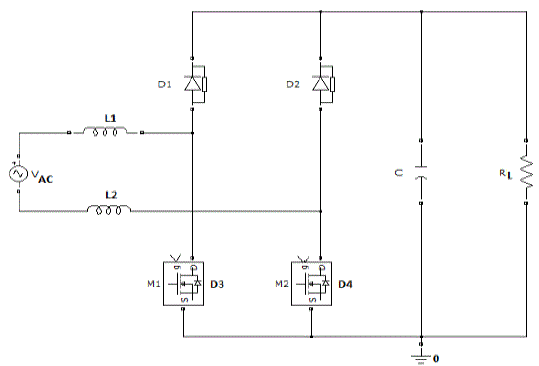 |
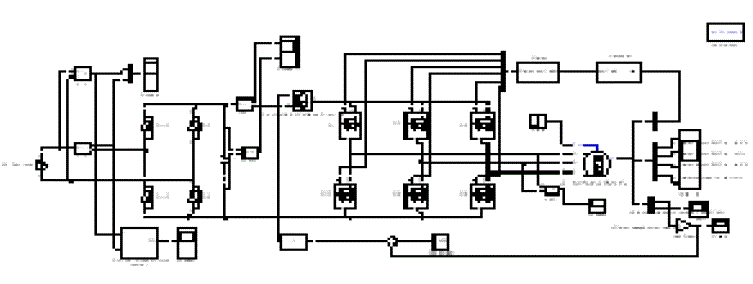 |
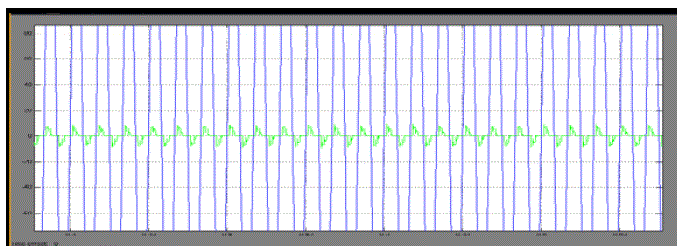 |
| Figure 1 |
Figure 2 |
Figure 3 |
Figure 4a |
Figure 4b |
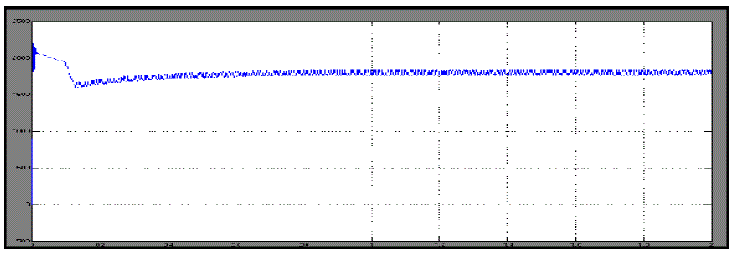 |
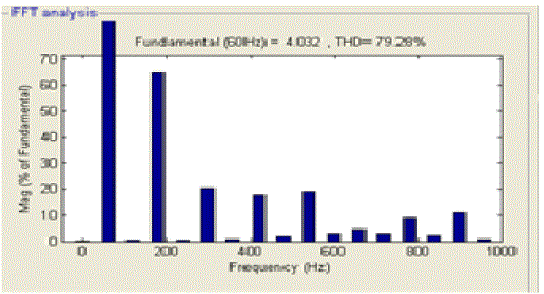 |
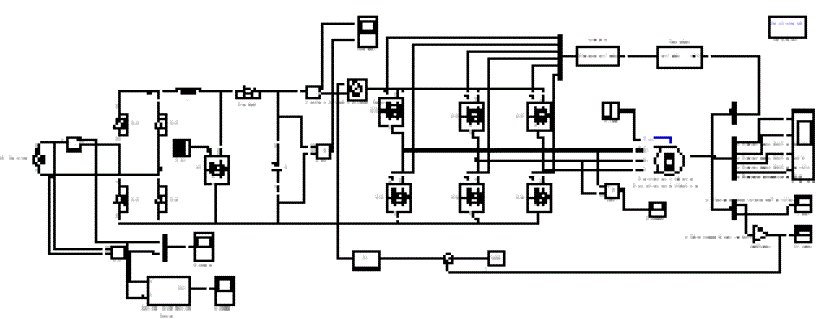 |
 |
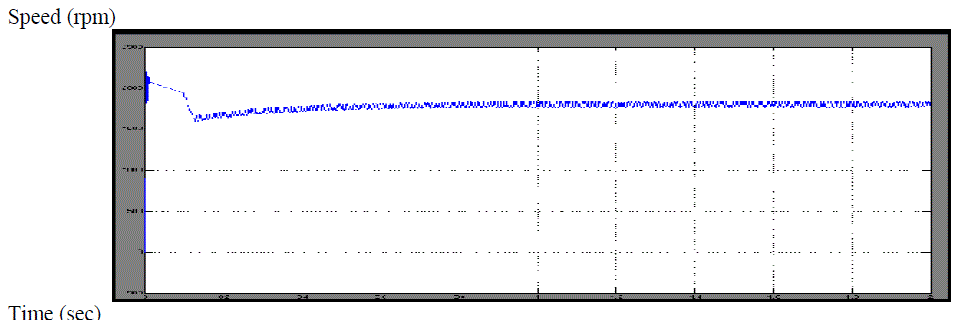 |
| Figure 4c |
Figure 4d |
Figure 5a |
Figure 5b |
Figure 5c |
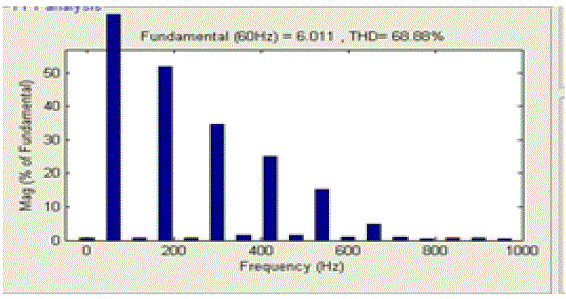 |
 |
 |
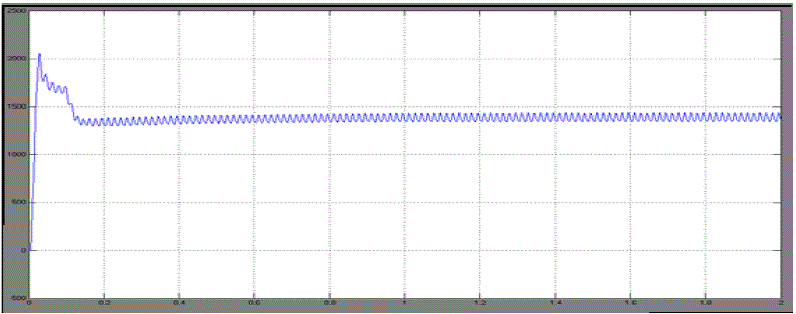 |
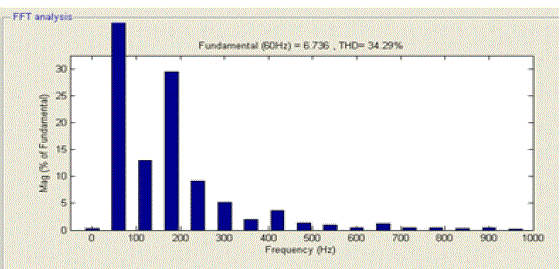 |
| Figure 5d |
Figure 6a |
Figure 6b |
Figure 6c |
Figure 6d |
|
References
|
- C. Umayal, S. Rama Reddy. “Modeling and Simulation of Closed Loop Controlled PFC Half Bridge Converter Fed PMBLDC Motor usingSimulink”. International Journal of Electrical Engg. ISSN 0974-2158 Vol. 4, No. 3 (2011), PP. 375-387.
- C. Umayal, S. Rama Reddy. “Implementation of Bridgeless Boost converter Fed PMBLDC Motor Drive Using PIC”. IJEE Vol. 2.No.1, 2012PP.
- Tay Siang Hui, K. p. Basu and V. Subbiah, “Permanent Magnet Brushless Motor Control Techniques”. National Power and Energy Conf.(PECon) 2003 Proceedings, Bangi, Malysia.
- P.Thirusakthimurugan, P.Dananjayan, “A New Control Scheme for The Speed Control of PMBLDC Motor Drive” 1-4244-0342-1/06/$20.00©2006 IEEE.
- SalihBarisOzturk, Hamid A.Toliyat, “Sensorless Direst Torque and Indirect Flux Control of Brushless DC Motor with Non-Sinusoidalbackemf”,978-1-4244-1766-7/08 ©2008 IEEE.
- Laszlo Huber,Yungtaek Jang, Milan M. Jovanovic, Performance Evaluation of bridgeless PFC Boost Rectifiers, IEEE Trans ,PowerElectronics.,vol.23,No.3, May 2008.
- J. C. Salmon, “Circuit topology for single-phase voltage-doubler boost rectifier”, in Proc.IEEE Applied Power Electronics Conf., Mar. 1992,PP. 549-556.
- DeepshikhaJaiswal, Mr. K. P. Singh, Dr. A. N. Tiwari, “Analysis of Bridgeless PFC Converter”, (IJERT)International Journal of ElectricalEngg. ISSN. 2278-0181, Vol. 1, Issue 5, July-2012.
- Woo-Young Choi, Jung-Min Kon, Eung-Ho Kim, Jong-Jae Lee and Bong-Hwan Kwon, “Bridgeless Boost Rectifier with Low Conduction Losses and Reduced Diode Reverse-Recovery Problems”, IEEETransaction on Industrial Electronics, Vol. 54, No.2, pp.769-780,April 2007.
- R.Srinivasan and R.Oruganti, Analysis and design of power factor correction using half bridge boost topology in Proc. IEEE APEC ’97, Feb.1997, Vol.1, pp. 489-499.
- Lu, R. Brown, and M. Soldano, Bridgeless PFC implementation using one cycle control technique, IEEE Applied Power Electronics (APEC)Conf. Proc., pp. 812-817, Mar. 2005 Mar. 1995, pp. 473–479.
|